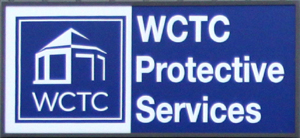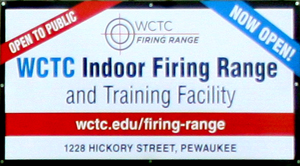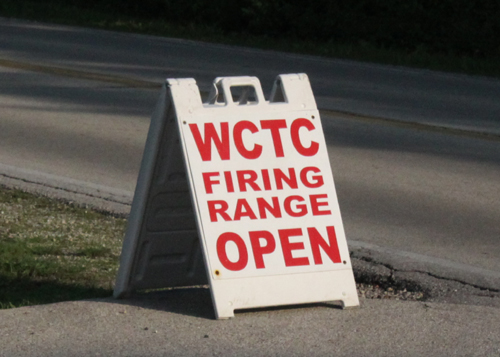 WCTC Firing Range
WCTC Firing Range
1228 Hickory Street
Pewaukee, WI
Yearly
membership fee $10
Range fee $8 half hour/$15 hour
Hours vary according to LEO training (See below)
Range fee $8 half hour/$15 hour
Hours vary according to LEO training (See below)
As an avowed firearms enthusiast, I like to shoot There was a time when I went shooting every week. This was usually outside in the country. I had friends with land, knew of some quarries and other bits of private land where, for a fee, firearms were welcome, and I always enjoyed myself; but I didn’t always enjoy going to the local indoor ranges. This has recently changed, and I now shoot at an indoor range about six blocks from my house. This range is everything an indoor range should be, and doesn’t cost a fortune to use.
The problem with most indoor pistol ranges is that they are dark, dingy, reek of gunpowder, and will have several bays out of order or at the very least not entirely functional. There are a number of reasons for this. Most ranges are a part of the facilities of a firearms dealer, and are thus of secondary consideration. In many cases the range is a loss leader, and no profit is expected from it.
Hidden away in the little village of Pewaukee, is an underappreciated gem for Milwaukee and Waukesha area firearms owners and sporting enthusiasts, as well as those who wish to maintain or develop defensive firearms skills. It is the WCTC Firing Range. The range is wonderful. It is clean, well lit, safe, computer controlled and well maintained. The staff members are friendly, knowledgeable and welcoming.
The range is state of the art, as is should be, considering its purpose. This was not initially designed as a recreational shooting range, or an addition to a gun dealership. It was built to train current and future law enforcement officers taking police science classes at WCTC. It is also used by various local law enforcement agencies for training and currency.
It is an encouraging sign to see an accredited educational institution supporting firearms training and recreation, for civilians as well as law enforcement officers. At one time, many schools (including UWM) had shooting teams and through ROTC had military training facilities, including shooting ranges. Sadly, these days most do not.
The facility has several sections including a nice lounge area, classroom, interactive shooting area, lobby with service counters, and rest rooms. The parking lot is large, and it appears that the building has some room for expansion.
The double layer entryway opens onto the lobby and service counter. This counter is staffed, and is where you go to sign in for a shooting lane, a league, or to register for membership. The service counter offers a variety of targets and ammunition for purchase, and requires all ammunition brought in be either factory ammunition, or loaded to factory specs – no hot loads (additionally, no bird shot, frangible bullets, tracers, incendiary, or armor piercing - for obvious reasons). This is also where you register for membership, and public classes. As a non-commercial venue, no firearms are sold here. There are also no firearm rentals, at least not as of this writing.
Across from the service counter is a storage locker area. To the right of the counter is the lounge and observation area.
Classroom
The classroom looks like any classroom you might find at your local college. Long tables, chairs, academic style fluorescent lighting, as well as a substantial video monitor, and a pair of large whiteboards fill the room.
In addition to the law enforcement classes, civilian classes in self defense are taught here, as well as classes designed to satisfy the training requirement for the Wisconsin CCW permit. Other more advanced classes in civilian self defense are being considered.
The classroom is
Lounge/observation
area
Off to the right of the service counter is the lounge area, which gives access to the range. The lounge area has tables, snack machines, and a large video monitor mounted on the wall. The video monitor is flanked by the names of some of the range's top shooters, inscribed onto metal strips. There are many blank spaces right now, as the range is still new; but the numbers will grow.
The lounge area also gives access to rest rooms, and hand washing facilities. Though the range is well ventilated, a shooter will still find lots of powder residue and assorted black gunk which needs to be removed from the hands after shooting.
A fire extinguisher, and fire alarm - one of many - is stationed here. Despite the cinder block walls, and heavy construction of the facility, you wouldn't want a fire here, and no firefighter wants to battle a blaze in a building full of live ammunition.
Range
Area
The range area is brightly lit, though several special levels of illumination are available to recreate nighttime, and even to mimic the flashing lights of a police strobe. It is also very well ventilated, without the grungy soot and smoke associated with most ranges.
This is a 25 yard pistol range, though long arms firing handgun cartridges are also allowed, as well as those firing the 223 (5.56) round typically used by the military. The backstop is said to be capable of withstanding more powerful cartridges, but for longevity it is limited to the pistol and AR rounds.
In contrast to many ranges at which I have shot, the range area here is very well ventilated, and does not have that smoky, dingy, unpleasant feel. It is also very well lit, both on the shooter's side, and out in the range area itself. Though, for obvious safety reasons, it is of concrete and cinder block construction you do not feel like you are in a dungeon.
The range offers 12 modern shooting stalls, all of modular construction, and each with sufficient lighting, ventilation, and a touch screen panel to control the computer operated target holder. This state of the art set up is pleasant to use, and can be quite challenging, due to the programmable features in the Man-Com target controllers.
These new controllers can be used manually to set the targets out to the desired distance, but can also be used for for automated speed drills and timed events, for challenges which move the targets up and down the range, and for shifting the lighting to represent different day/night scenarios.
The target retrievers ride on rails installed across the ceiling, rather than the pure cable systems used in many other ranges. This prevents the bouncing, jerking, and sagging that often occurs with pure cable systems. It also means that you do not have to stop and wait while your target settles down, before shooting. This is the Mancom Touch Plus system, and is capable of turning the target at 360 degrees, and of being controlled from individual shooting stalls, or from a central location. Mancom claims an accuracy of an inch or less in retriever positioning.
The range is clean and clear of any distraction or clutter. Ceiling baffles allow for bright lighting that does not send any glare into the shooters' eyes. This is a particular consideration when shooting glasses are required.
A close up of the touch screen controller shows its basic simple commands. The menu driven system offers lots of options. Digital control also offers easy upgradability.
A central control station is visible at the back of the range, along with a ready area that includes a couple of tables and some chairs. Safety notices are everywhere. Safety and security are enhanced by a series of fire alarms, and also be a set of security cameras monitoring the range. Loudspeakers make sure that range commands can be heard through even the most secure hearing protection.
For guests, friends, fellow shooters, or casual observers, four large bullet resistant windows allow a good view of the range from the lounge area, and allow shooters to look out into the main portions of the facility. The thick paned glass, in addition to resisting the effects of bullets, also help to abate the sound.
Interactive Shooting
One of the big features of this range is its interactive shooting area. This is still a work in progress and was originally conceived as a sort of an indoor version of Hogan's Alley, where trainees would walk a gauntlet of threats and non-threats, and have to make split second decisions,
At present, this part of the range is not generally open to the public. The exception to this is when civilian self defense and advanced CCW classes are offered. The reason, I suspect, is the expense of the system, the need to provide a specially modified firearm for every participant, and the requirement to have a range-master/tech, who knows and can operate and calibrate the system.
So really there are two parts to this area. The first is the area itself, with its structures,
There is no other way to phrase this - the training system is fun, sort of like an overgrown video game. Everyone who used it was very enthusiastic. Everyone wanted a turn, waited in line, and we all got just a little bit competitive. The whole layout of the pace, with its roofless houses, and potted trees made it all just a bit surreal. Generally, when you see facilities like this, you might see alleys, and store fronts with names like the Handy - Heist Market, or the Stop and Rob.
Little Green Men?
A number of these little rolling torsos were racing around the interactive portion of the range during my visit, and it appears that someone was being quite entertained by running them around. Sadly, visitors were not invited to play with or race the little green men, though we had plenty of other things to play with.
The interactive training is done largely through a simulation system called the Milo Range, the control consoles for which are shown in the photo below, and live ammunition is not used in this area, at least for the time being. Yet who knows what the future may bring. The system uses screens, projectors, a laser sensor system, and a laser unit installed in a real firearm.
The guns used in the system are real, though they can not chamber live ammunition until the laser units are removed. The laser units are actuated by the same firing pin that in ordinary use would strike the primer to fire live ammunition. So safety and trigger operation are identical to the real thing, because they are the real thing. The example guns we used at the demonstration were base upon the well regarded Glock pistol, and had no recoil, but recoil kits are available to add an extra dimension of reality and difficulty.
Men having fun
Things you should
know
Hours (can vary,
but as of this writing are)
|
Fees
|
Permitted weapons
(Taken from range website)
|
Permitted
Ammunition (Taken from range website)
|
links
WCTC
Range - official siteMembership Application
Facebook Page
Milo range
man com